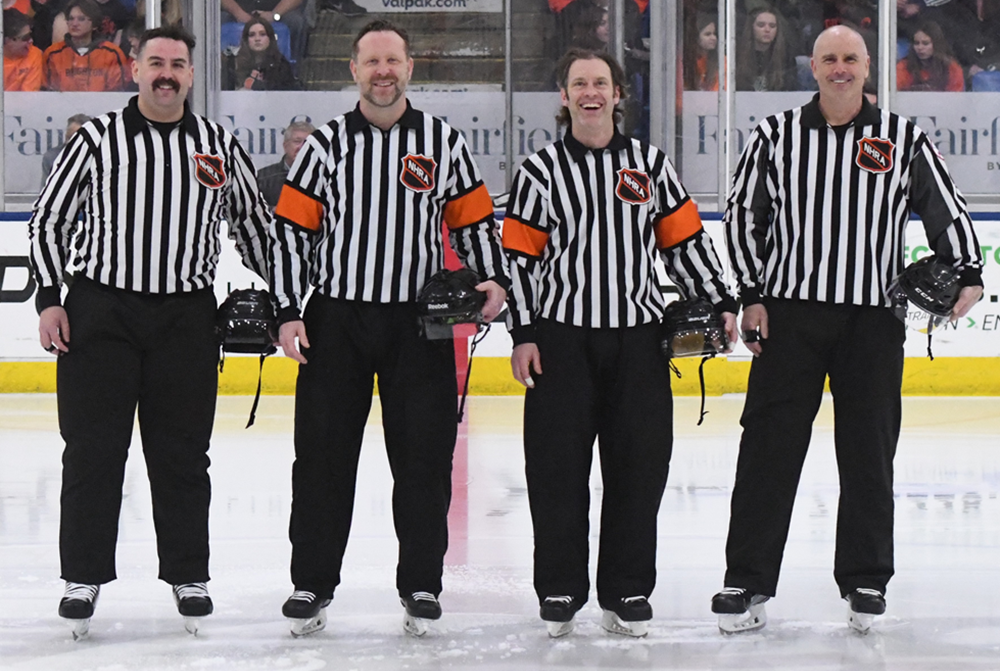
Be the Referee: Helmet Comes Off
October 26, 2017
In this week's edition, assistant director Mark Uyl discusses a recent football rules change geared to improve safety in situations after a player's helmet comes off during play.
Be The Referee is a series of short messages designed to help educate people on the rules of different sports, to help them better understand the art of officiating, and to recruit officials.
Below is this week's segment – Helmet Comes Off - Listen
All rule changes in the game of football, at all levels over the past decade, have been geared mainly to improve player safety.
One of the rules that has come recently deals with players and their helmet. Whenever during the course of play a player’s helmet comes off during the down, that player must leave the game for a minimum of one play for an evaluation to take place to make sure that no possible concussion or head injury has occurred.
Plus – when that helmet comes off a player – we treat that just like an injury situation, to where even a timeout can’t buy that player back into the game to make sure that the proper evaluation has taken place.
Past editions
October 19: Goal Line Rules - Listen
October 12: No 1st-Year Fee - Listen
October 5: Athletic Empty Nesters - Listen
September 28: Misunderstood Football Rules: Kicking - Listen
September 21: Preparation for Officials - Listen
September 14: Always Stay Registered - Listen
September 7: Other Football Rules Changes - Listen
August 31: Pop-Up Onside Kicks - Listen
August 24: Blindside Blocks - Listen

Be the Referee: Hockey Officials
By
Paige Winne
MHSAA Marketing & Social Media Coordinator
March 5, 2024
Be The Referee is a series of short messages designed to help educate people on the rules of different sports, to help them better understand the art of officiating, and to recruit officials.
Below is this week's segment – Hockey Officials - Listen
Throughout the high school hockey season, you are used to seeing three officials on the ice. But starting in the Quarterfinal round, four officials are used. The four-person system utilizes two referees and two linesmen. And that’s used for quarters, semis and the Finals.
This system allows for more coverage. The two referees can concentrate on penalties and other rules. The two linesmen's primary duties are offsides and icing.
The move to four officials allows for more consistent coverage of the fastest game in the MHSAA. And like we do in other sports, the best officials are chosen for the final rounds.
Previous Editions
Feb. 27: Less Than 5 - Listen
Feb. 20: Air Ball - Listen
Feb. 13: Hockey Penalties - Listen
Jan. 30: Wrestling Tiebreakers - Listen
Jan. 23: Wrestling Technology - Listen
Jan. 9: 3 Seconds - Listen
Dec. 19: Unsuspecting Hockey Hits - Listen
Dec. 12: No More One-And-Ones - Listen
Nov. 21: Football Finals Replay - Listen
Nov. 14: Volleyball Unplayable Areas - Listen
Nov. 7: Pass/Kick Off Crossbar - Listen
Oct. 31: Cross Country Interference - Listen
Oct. 24: Soccer Overtime - Listen
Oct. 17: Tennis Spin - Listen
Oct. 10: Blocked Kick - Listen
Oct. 3: Volleyball Double & Lift - Listen
Sept. 26: Registration Process - Listen
Sept. 20: Animal Interference - Listen
Sept. 13: Feet Rule on Soccer Throw-In - Listen
Sept. 6: Volleyball Jewelry - Listen
Aug. 30: Football Rules Similarities - Listen
Aug. 23: Football Rules Differences - Listen

